Abbot Mark Cooper, O.S.B. ’71, who has been abbot of Saint Anselm Abbey since 2012, and a student, monk, administrator and educator prior to that, turns the page to the next chapter of a long and distinguished career at Saint Anselm College.
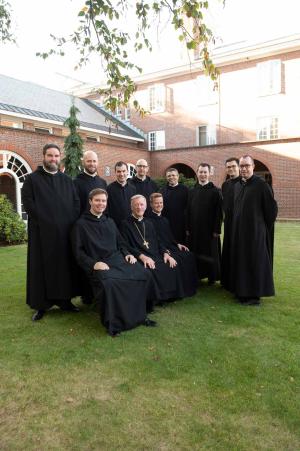
In 1967, a student recently graduated from high school in Freeport, Maine, arrived on the campus of Saint Anselm College filled with anticipation and a desire to find his path in the world.
Two of his uncles were members of the monastic community, which meant Arthur Cooper was more familiar with Saint Anselm than many of his first-year classmates: Fr. Jude Gerry, O.S.B. had passed a few years earlier in 1963, and Fr. Joseph Gerry, O.S.B. '50 would become abbot at Saint Anselm a few years later in 1972. Still, the priesthood was not on the mind of the young freshman.
Fifty-seven years later, Abbot Mark Cooper, O.S.B. ’71 recently reflected on the journey from those early days on the Hilltop, to his graduation in 1971, his profession of monastic vows in 1972, his year of teaching at Woodside Priory School in California, and back to Saint Anselm where he was ordained a priest in 1976, served as treasurer and vice president of finance for 33 years, and then as abbot since 2012.
At the age of 75, following the rules of the American-Cassinese Congregation of Benedictine monasteries, which includes Saint Anselm Abbey, an abbot must submit his resignation. While he then may be re-elected, Abbot Mark made the decision to retire from the leadership role he held for more than a decade.

for Abbot Mark, shown here during Benedictine Heritage Week this March, and an earlier decade, below.
“I said to our prior, Fr. Augustine, ‘For the first time in 45 years, I look at what’s ahead of me and it’s not an image of one thing constantly following another’,” Abbot Mark says. “So that’s been nice. There was no break between being CFO and abbot so I was going at a pretty fast pace and kept right on moving at that speed.
In monastic life, the abbot is the superior of the community on both spiritual matters and temporal matters, such as managing the budget and operational decisions. For instance, the abbot deter- mines the work each monk will perform and who will serve as monastic superior at Woodside Priory and as pastor of Saint Raphael’s Parish in Manchester, N.H.
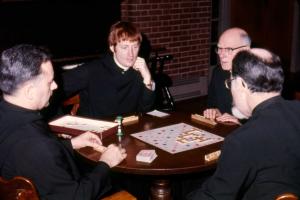
“I would say we have an excellent monastic community. I entered 53 years ago, and, in my mind, we’ve always had a strong community life, and I’m grateful for that,” Abbot Mark says. “I believe we have maintained a good expression of the elements of the monastic life, which pulls us together and makes us a stronger community, so we have been very fortunate.”
At Saint Anselm, the abbot also serves as chancellor of the college, ensuring that the Catholic and Benedictine mission and identity remain central. Along with college President Joseph A. Favazza, Ph.D., Abbot Mark was an ex-officio member of the Board of Trustees.
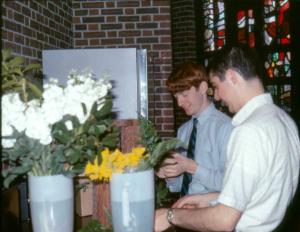
“Abbot Mark’s guidance, faithful leadership, and service has ensured that Saint Anselm’s distinct Benedictine living-learning community will be here for future generations of Anselmians,” says Joseph Loughrey, chair of the Board of Trustees. “I have been blessed to work closely with Abbot Mark and Dr. Favazza, and it is clear that the growth and progress of the college would not have been possible without Abbot Mark and the monastic community.”
After graduating from Saint Anselm in 1971, Abbot Mark studied at Saint John’s Seminary in Boston and St. Albert’s Seminary in Oakland, Calif. While in his final year of seminary at St. Albert’s, he was a high school teacher at Woodside Priory in Portola Valley, Calif., the only co-ed Benedictine college preparatory school in California, which has been affiliated with Saint Anselm since 1975.
He then earned an M.S.A in business administration from the University of Notre Dame in 1979 while working in the college’s business office from 1976 to 1979. He was named treasurer and chief financial officer in 1979, where he was initially responsible for all financial matters of the college, including the development and oversight of the operating budget and investments, along with managing Food Services, Physical Plant, the Office of Safety and Security, Student Financial Aid, Human Resources, Information Management Services, and the Bookstore.
In my time here, and well beyond that, Abbot Mark has been our SPIRITUAL LEADER guiding in his soft-spoken, gentlemanly way with a CLEAR SENSE OF PURPOSE.
After 33 years, he was set to retire as vice president of financial affairs in 2012, but his service to the college community was far from over.
When Abbot Matthew Leavy, O.S.B., announced his decision to retire after 26 years, the monastic community elected Fr. Mark Cooper as the next abbot—only the fifth abbot in the history of Saint Anselm College.
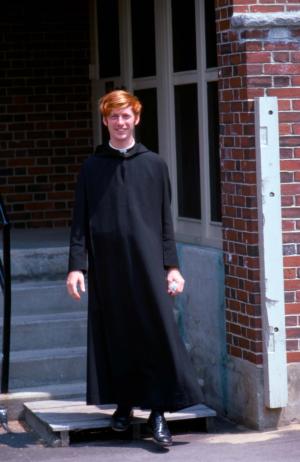
Saint Anselm has seen significant growth and change during Abbot Mark’s leadership, while remaining grounded in Catholic teaching and Benedictine hallmarks—such as stability, conversion of life, and obedience—that serve as the foundation of the college.
“In my time here, and well beyond that, Abbot Mark has been our spiritual leader, guiding in his soft-spoken, gentlemanly way with a clear sense of purpose. He is the embodiment of the college’s mission and identity, faithfully ensuring the values remain strong, the history is remembered, and the future remains true to its deep roots,” says Dr. Favazza. “And under Abbot Mark’s leadership, the Saint Anselm Abbey community is as strong as ever, the college is as strong as ever, and personally, I have Abbot Mark to thank for helping me, as a new president, to learn and grow as a member of this special community.”

Having experience both as the head of finance and as chancellor of the college, and with a keen eye on the long-term—a trait that comes with a vow of stability taken by all Benedictine monks—Abbot Mark’s perspective has been a valued one even in the most challenging of times.
He was awarded the Alumni Award of Merit in 2003 and an Honorary Doctorate of Finance in 2004 for his contributions to the development of the college. “With his even temper and legendary Yankee thrift, he has labored steadily and calmly through bull markets and bear markets, through times of abundance and times of need, always advancing the vision of making Saint Anselm an outstanding Benedictine college,” read his honorary degree citation.
He held numerous leadership roles in higher education, including serving on a total of 17 visiting teams for the accrediting body for colleges, the New England Association for Schools and Colleges (now NECHE). He also served for several years on a special committee of NECHE which annually reviewed and reported on the status of financially- troubled institutions of higher education in New England.
In New Hampshire, he was a board member of the New Hampshire Higher Education Assistance Foundation. For 15 years, Abbot Mark was a board member of First Signature Bank in Portsmouth, N.H., whose parent company was John Hancock.
Both as abbot and before, Abbot Mark served on nine visiting teams evaluating Benedictine communities of the American-Cassinese Congregation in the United States. He served for 26 years as financial counselor to the abbot president and his council of the American-Cassinese Congregation. As abbot, he was elected three times as a member of the abbot president’s council.
I said ‘I really want to try this (monastic life).’ So I entered and that was it... I was attracted to THIS PLACE, THIS LIFE, THESE PEOPLE.
Abbot Mark’s time leading the Abbey has been marked by notable growth within the monastic community, with more than a dozen new monks joining the monastery, many of whom are recent graduates, with two more expected to enter the monastery during the year. Few religious communities have seen an increase in numbers like that of Saint Anselm Abbey.
Abbot Mark respectfully deflects any emphasis on his role. “Much of it,” he says, “is that you acquire some good young people, and they are then very influential in attracting others.”
The Rule of Saint Benedict places significant emphasis on the role of the “abba,” in which the abbot must show “the rigor of a master” as well as “the loving affection of a father.” All important permissions in the monastery come from the abbot, and as a result the culture of the community closely mirrors the leader of the house.
Thinking of his own experience, Abbot Mark said that if someone had suggested to 18-year-old Arthur Cooper that he consider religious life, he would have dismissed the idea.
“It was getting to know some of the young monks, getting to see what they did. And after four years here—I actually applied to graduate school—but then I said ‘I really want to try this (monastic life).’ So I entered and that was it,” he says. “Had I left, I wouldn’t have said, ‘well, I’ll look into another religious order or the priesthood.’ That would have been it. I was attracted to this place, this life, these people.”
Fortunately, he followed his calling and his journey has been one of loving stewardship of his beloved Saint Anselm home. During the President’s Society dinner in June, Abbot Mark’s legacy was celebrated by co-workers, students, colleagues, and his close friend and former classmate, Trustee Robert Savard, ’71, who made sure to toast him rather than roast him as he was presented the President’s Award.
In formal occasions, the abbot is clothed in the ceremonial dress of a prelate, including wearing a mitre and carrying a crosier. Since 2012, Abbot Mark has carried the bearing of his spiritual leadership role with reverence and authority. So it might come as a surprise to those who find him spending certain early-morning hours in shorts and a t-shirt, weeding the grounds of the college or picking up litter. But Abbot Mark enjoys those quiet moments caring for his home.
Since he retired from abbot duties in April, he has found more time for this humble, meditative activity. On a sweltering June day earlier this year, he was seen meticulously dead-heading geraniums near the Roger and Francine Jean Student Center to be sure they continued looking their best and producing blooms throughout the summer.
“It’s nice,” he says. “I’ve been doing a lot more work on our grounds on campus, and I find that both relaxing and rewarding.”
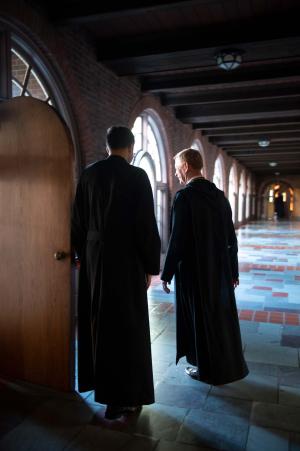
For Abbot Mark Cooper, O.S.B. ’71, following his calling resulted in a career spanning five decades at Saint Anselm, with his time as abbot seeing notable growth for the Abbey, including more than a dozen young monks joining the monastery.
